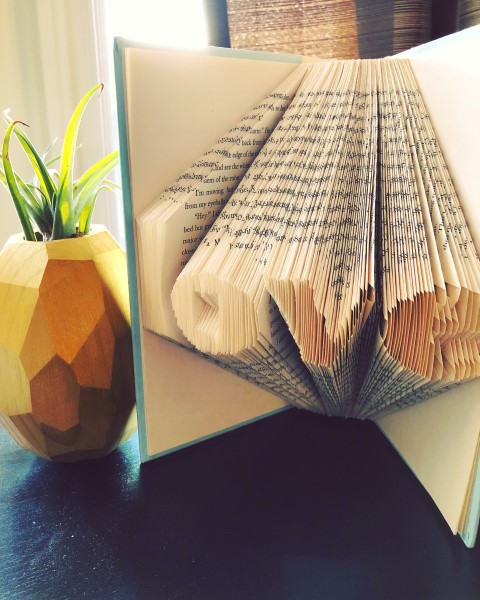
Tips to make beautiful folded book art + free templates

Isn’t this the coolest folded book art you have ever seen? I saw this style of folded book at a store one day and thought, “I can make that myself!” After a few months of procrastination, some Googling and a couple misadventures in book folding, I’ve learned some best practices to fold words onto the pages to make the most lovely folded book art.
These folded books make for great gifts for weddings, baby showers, birthdays and a lovely addition to any home or office. Follow my beginner book folding tips below to get started.
How folded book art is created
To wrap my head around this mind-boggling concept, I turned to Youtube to watch what this book folding art process looked like. I watched a bunch of videos like this one below.
Free book folding art templates to download
For those of you that are not handy with Photoshop, here is a free book folding template that you can print yourself. Print the book folding pattern in landscape orientation as it will come out on more than one sheet of paper.
This free book folding art pattern is for the word “love.” I have built it out in three different sizes depending on how many pages your book has. Choose the template that has less pages than the book you have. For example, if your book has 476 pages, choose the smaller 450 page book folding template to use. This is a difference of 26 pages so count out half of the pages (13) in the front that will not be folded. Once done following the book folding template, you will have 13 pages left in the back as well).
Love – 350 page book folding template
Love – 400 page book folding template
Love -450 page book folding template
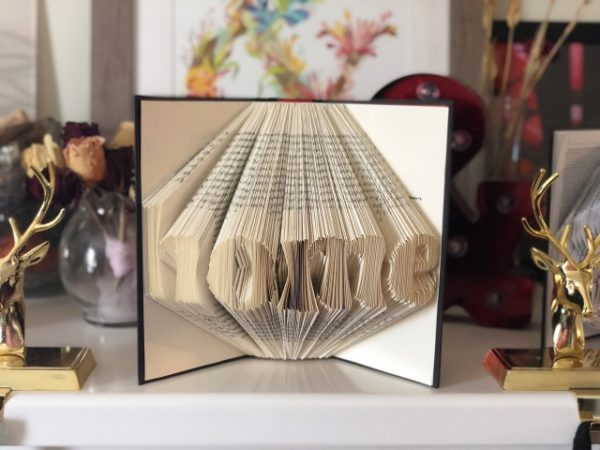
Choosing the right book to fold
- Find nice hardcover books at thrift stores around the city. I also love to stock up on books at annual book sales like CBC Calgary Reads Big Book Sale or the RESET Society of Calgary book sale. I recommend buying books with at least 300-400 pages as that will usually cover most words to fold.
- I find that 4-5 letter words are the best length to work with. I have done upwards of 7 letters, but the problem is that your book will fold into quite the crazy accordion which makes it hard to actually read the word. Less is better.
- You’ll need about 80 pages approximately per letter although this can vary depending on how think your page sheets are, how long the book is etc.
- Pull back the cover jacket on the hardcover book to see what is underneath. All books have beautiful covers and colors to choose from especially if you’re looking to do a specific décor theme. Sometimes you may want to find a specific book to use if there’s a special memory attached or for someone’s favourite author and the like. Steer away from the mystery book section – I find the titles of the books don’t make for very nice gifts to other people lol.
- Make sure the edges of the pages are flat. Sometimes books are intentionally published with a deckle or “jagged” edge but this will make your craft project so much harder to fold.
- I prefer books that are not too tall and not too small. As the folded book art is meant to be home décor, you want to find an appropriately-sized book in both cover size and number of pages to use.
- Check that the spine and pages are intact. You don’t want pages to fall out as you’re folding
- Make sure pages are easy to fold. I made the mistake of buying an older hardcover book that was quite well worn. The pages were very thick and “pulpy”. As I was folding, the pages would start cracking and ripping easily. Needless to say, this was very frustrating to have it fall apart as I was trying to make something beautiful.
- Have an extra folding book handy to use as practice. My first folding book art was full of folding issues and turned out crap.
Easy book folding art tutorial
UPDATE November 2020: I have to give full credit to the former see-saw blog for this tutorial! I have been following this method for years. Now that her site is no longer working, I am adding in this info here, but we wouldn’t be able to do this without her amazing expertise. Thank you!
There are a few different ways to make these books with many book folding templates available on the Internet. But the folded book art tutorial below is my preferred method. Trust me, I looked at a lot of different options, but I like this particular method because it:
- Provides a very handy Photoshop template to update and modify or you can borrow one of mine above for free.
- This template allows you to use any font and any word that you like.
- You can also use books with different number of pages rather than having to find a specific book to use.
- No rulers or pencils are needed to mark off spacing and specs for every page. You just follow the template you create which is much simpler to use.
Supplies needed for book folding
- Photoshop on your computer
- Printer and 8.5 x 14 size paper (legal size)
- Scissors and/or box cutter
- Pencil
- Ruler
- Elastics (extra large)
- Heavy books or other weighted object
Setting up the book folding template
Spend lots of time checking your Photoshop template to ensure it is done properly and correctly.
Step 1: Download this blank PDF template and save to your computer.
Step 2: Open the PDF in Photoshop. You will see a series of lines with page numbers on both ends.
For those of you that don’t have access to Photoshop, I’m trying to figure out how to make a template on a more accessible tool like Word etc. but it doesn’t seem to work. In the meantime, ask a friend who knows how to Photoshop to help you get your template organized!
Step 3: Create a text box layer and input your chosen word e.g. home, Jessica, love, etc.
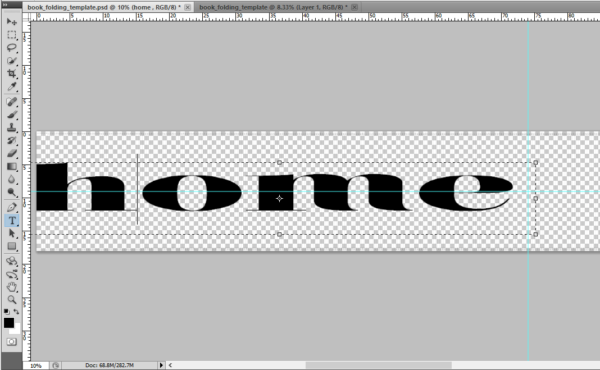
Increase the font size as needed to make the letters the height you want them to be. Think about how tall your book is and plan the letters accordingly leaving enough room at the top and bottom. I find I am often over 200 or 300 pt size depending on the font chosen. Center your word on your template to best match the cover size of the book that you are using.
Step 4: Drag your text box to the far left so that the beginning of your first letter is lined up to the very edge.
Now zoom your screen to about 50% so you can read the page numbers on the bottom of the template. Scroll over to the last letter of your word while keeping the page numbers visible.
Step 5: You now need to stretch your text box to match the number of pages in your book. With your mouse, select the right edge of your textbox (not the corners) and make the box wider. Pull the text box until the very last letter is lined up to the number of pages in your book. It helps to set up a ruler so you easily find the page number.
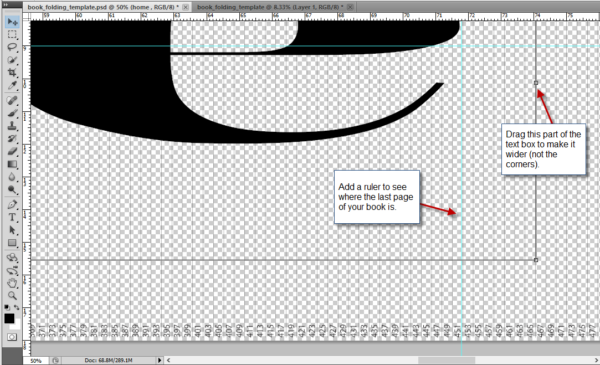
More font and template tips
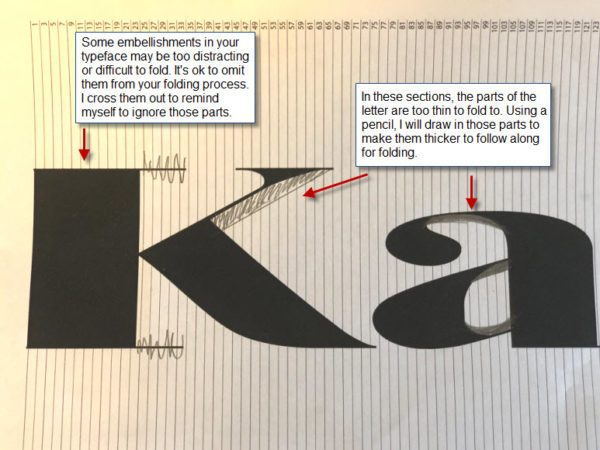
Make your letters “thicker” by hand
Play around with different fonts to make sure the letters are “thick”. As you fold the pages to match the outline on the template you won’t want the letters to be too skinny and hard to fold. I sometimes draw on my printed template to widen out parts of the letters that are too thin to fold to.
Interruptions in your font
Avoid having too many book folding breaks or “interruptions” in your chosen font/word. This happens with typefaces that have lots of embellishment like cursive fonts.
Try to have no more than three interruptions in your design. As you fold these parts of the word, you will find that you lose some detail as you’re trying to create multiple parts of a letter with a very limited number of pages available. See the picture below as an example.
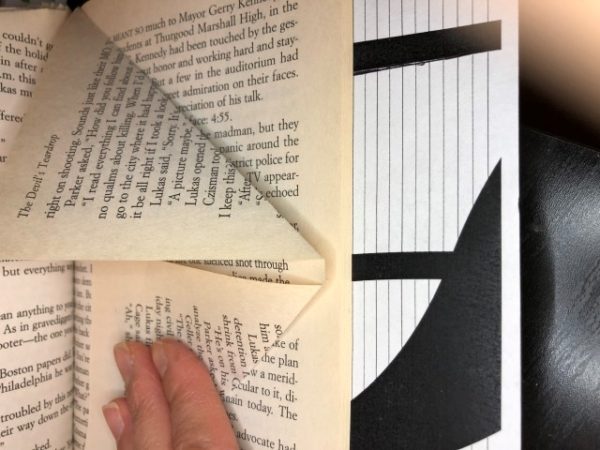
In this example, there are 3 black sections or “interruptions” all meeting at the same line. Try not to have more than 3 interruptions in your design as it can be too difficult to show the detail of the typeface.
Printing your book folding template
It’s time to print out your template! I prefer to use legal size paper as it usually means only 2 sheets to work with. You can use regular 8.5 x 11 paper as well, but you’ll probably end up with 3-4 sheets for your template.
You’ll need to play around with your printer settings to get the page to come out properly. I prefer to save the Photoshop file as a PDF and then printing horizontally onto the pages. I find everyone’s printer is a little bit different so you may need to do a few print runs until you get the template to come out full page.
Print your pages out neat and straight – if it comes out crooked on the copier then your folding will end up crooked too.
Do not print double-sided!
Setting up your book and printed template
So before we get folding, there are still a couple more preparation steps.
For your book, you need to set up a folding starting point on both the top and bottom.
Holding the book closed, looking down at the top of your book. Draw a line across all the pages of your book (about 1 inch away from the spine). Flip over and do the same thing to the bottom of the book as well.
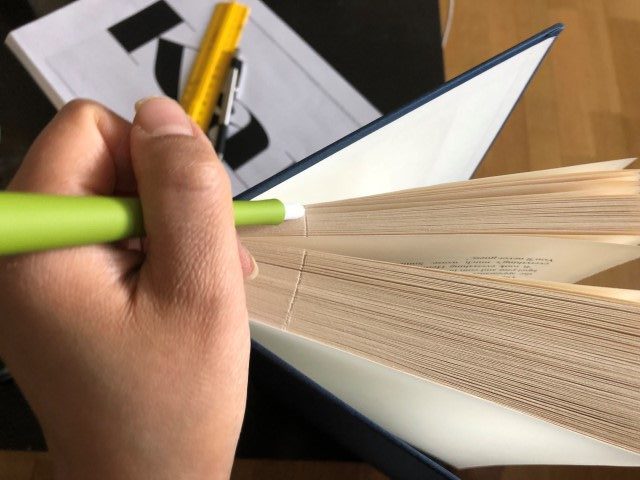
Using your box cutter or scissors, start scratching out a small divot along the line you just drew on the pages. This notch cutout will help you see where your fold line will start.
Complete the same notch cutout on both top and bottom of the book. Make sure this line is equal distance from the spine on both sides.
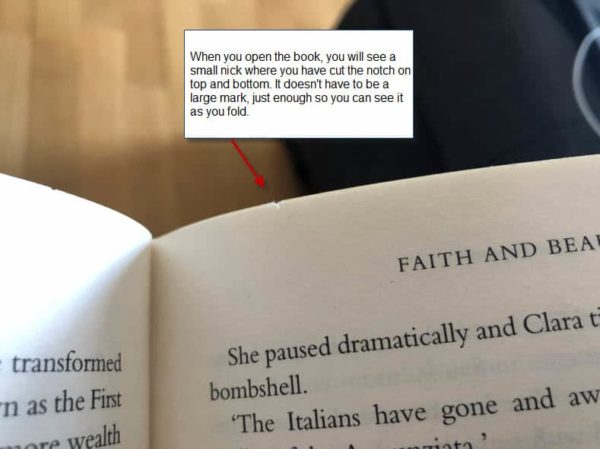
For your printed template, we need to create a folding edge to follow. On the long edge of your sheet (bottom of your word) create a 1 cm fold on your printed template. Do this to all sheets of your printout.
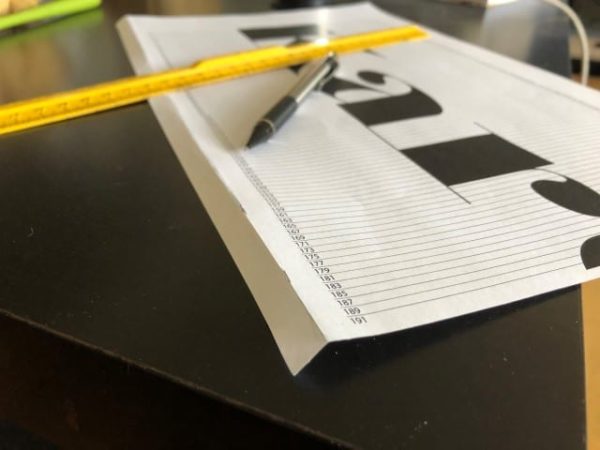
How to fold the pages of the book
Now it’s time to finally get book folding!
Place your book on a flat surface with the spine facing away from you.
Open up your book into the first 100 pages or so and place the folded edge of the printed template along the left side of the book (which should be the bottom of the book). Pull the folded edge tight along the edge of the pages of the book as this will keep your book folding straight and even (you don’t want your beautiful art to come out crooked!)
Pull the sheet in to start at line 1. Put the 100 pages you lifted back down.
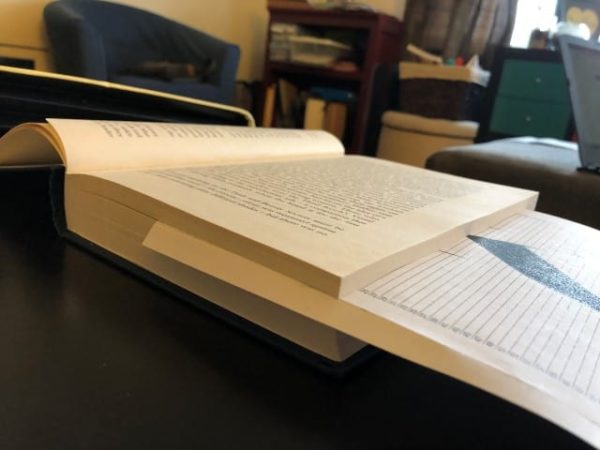
Open your book to page 1. Sometimes you may have a number of blank and introduction pages in the book before you get to the first page.
Starting with the left side of the page, take the corner and fold from the left notch cutout to where the letter begins. Crease the fold well. Repeat on the right side from notch to letter. Once both sides have been folded, flip the page over.
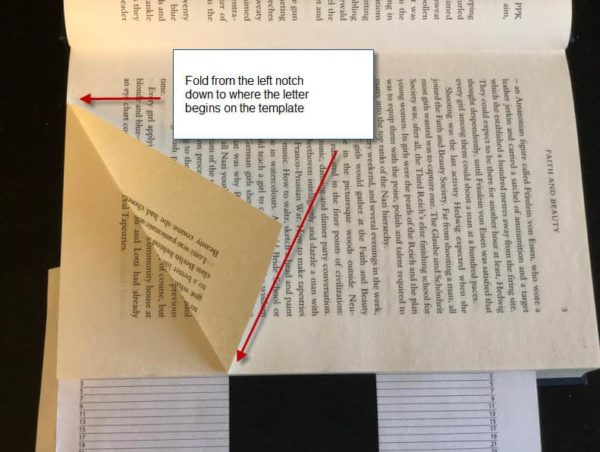
Repeat the folding process from left to right by moving your template sheet up one line as you fold the next page. Make sure the page number of the book is always matched up with the line number on your template.
As you fold, you will have to continually adjust the template by moving it below another stack of pages. Keep the folded edge of your template tight on every page.
You’ll get to a point where your template will then hit the spine of the page. Just fold over or rip off the section you have already folded (leave a little bit of a margin so you have something to insert back in the book to keep folding).
Continue this folding process until all pages of your book have been folded!
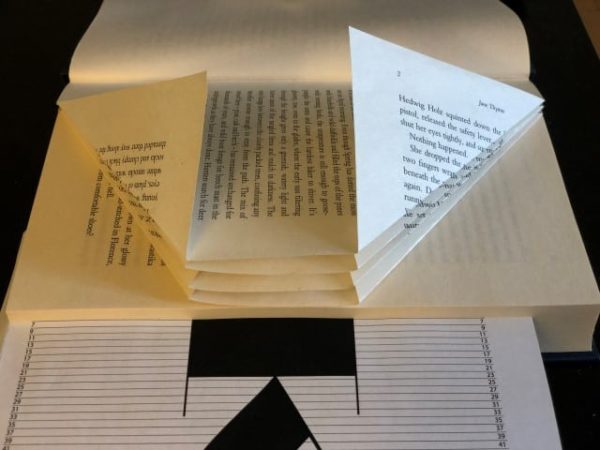
What to do when there’s more than one section to fold
You’ll get to a point in your template where you’ll have two or more different sections of a letter show up at the same line. Now what to do?
Starting on the left side, fold both corners of the page to match up with the first part of the letter. Ignore the second part of the letter. Flip page over.
Now on the next page, fold the corners of the page for the second part of the letter. Ignore the first part of the letter. Flip page over.
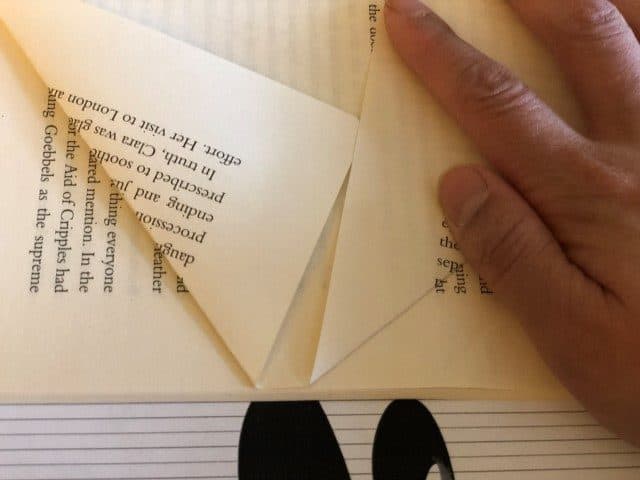
Continue alternating back and forth until your template goes back to a single folding part again. If your word ends up in three sections, follow the same premise of folding one part of the letter at a time until you complete the section. This is why it is important to choose fonts that limit the number of interruptions as mentioned above.
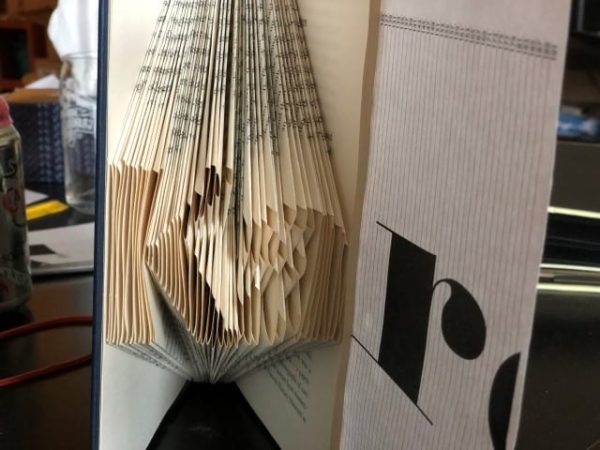
Tips during the folding process
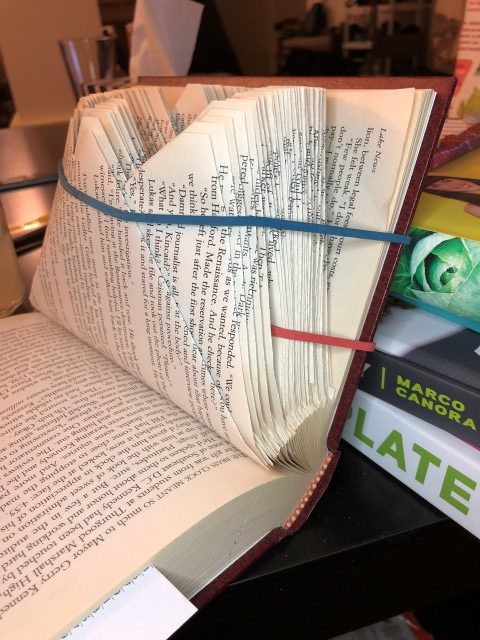
- Use heavy-duty books or weights to help keep your book from moving around as you fold.
- I like to use these extra big Staples rubber bands to keep the folded pages out of the way as I continue folding.
- With folded books that have 6 or more letters or if you find the spine of the book is weak, you may want to tie a ribbon around the bottom part of the book to keep your folded book art standing upright.
Are you ready to get folding? Practice makes perfect and I am totally here to help you along the way. Comment below or message me @heyseto if you need any feedback on your folded book art. Good luck!
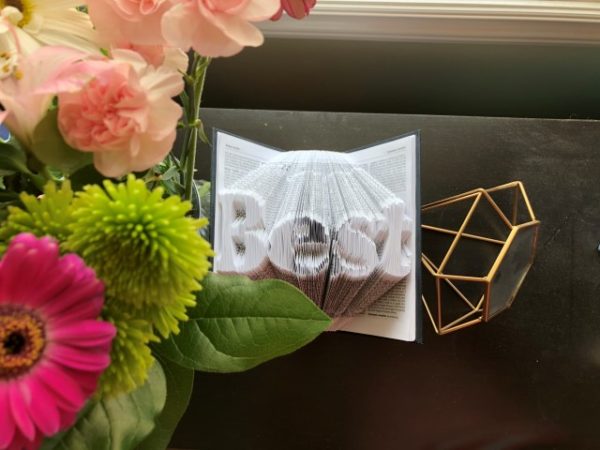
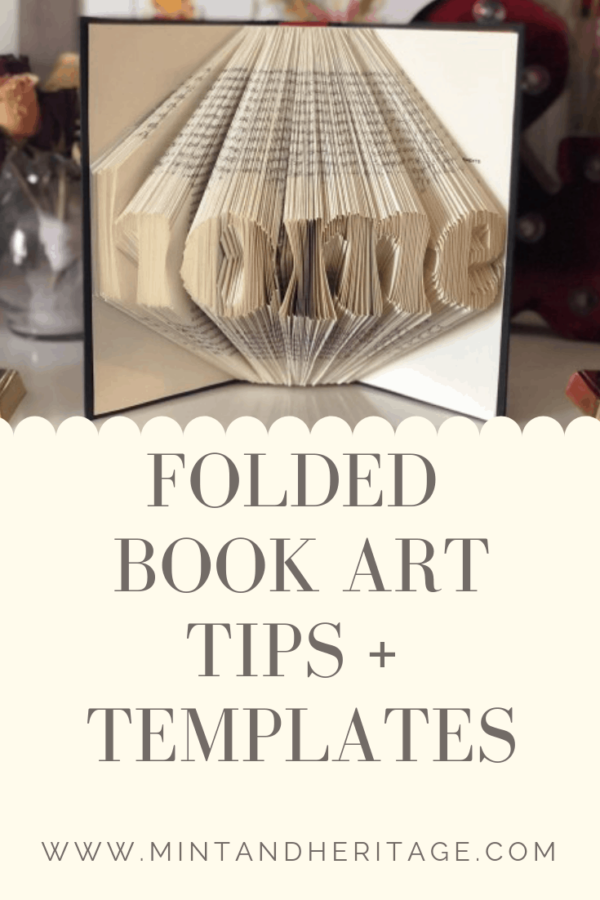





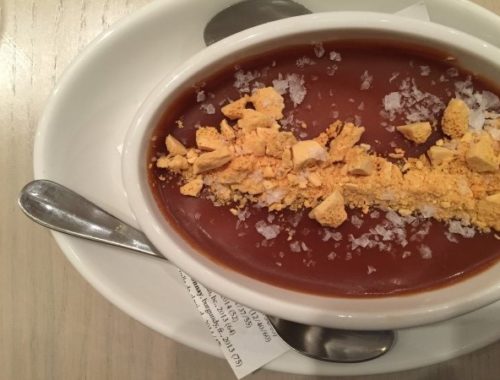
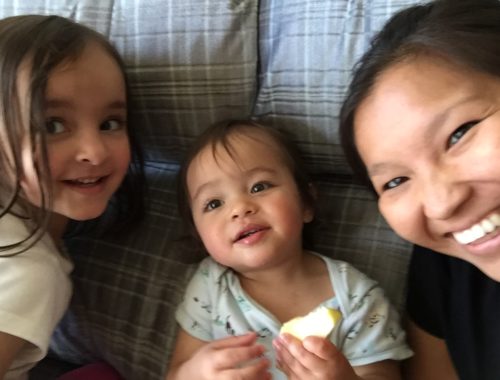
32 Comments
Rebecca Paylor
Hey,
I was wondering about page length.
Do you mean actually physically counting the pages?
Or do you mean by the bottom of the page numbers?
I have a book that is 364 pages as per the page numbers are the bottom of the book. However, it is roughly 182 actual physical pages.
What do you count by?
Thank you!
Becca
Irene Seto
Hi Rebecca, I usually look for books at least 400 pages based on the page numbers listed in the bottom of the book. Sounds like you have a good size book at 364 pages.
Sherrel Sheriff
I have a question about interruptions When trying to figure out how many pages you need your book to be do you need to count each interruption as a page? ie if you have 3 interruptions you would need 3 pages to fold – so that would actually add to your count in a book – Correct? Thank-you
Irene Seto
Hi Sherrel, if your template has a lot of interruptions you might want to fold more pages to help make those sections look more full and complete for the letter. What you can do is set up your template so that you extend/stretch the letters to cover more pages. For example, if you set up your template as 400 pages but your letters have many 3+ interruption sections, extend the letters to cover more pages so the overall template increases up to about 425/450 pages instead. Then find a book that will fit your template.
The example you listed would also work so you can add extra pages based on a multiplier of the # of interruptions and add that onto your page tally. You would need to remember where and when you are doing this as your book page numbers will stop matching the template at some point so it can be easy to get lost.
You don’t necessarily need to fold more pages when you have interruptions – it just depends on how the letters turn out. Often your eye will fill in any “gaps” on their own and the letters generally look fine. Just takes a little bit of practice to know when to adjust folds based on how much or how little you think is being filled in. Good luck!
Elisha Byron
Are you willing to make me a couple of personalized templates and I would happily pay you…I dont have photoshop
Beverly S Barker
love the “home” pattern. Do you have this pattern for sale or where I can find it. Thanks in advance
bevb
Lynn Spires
How do I download the book love
Tracy
I love how each book looks amazing. Have you ever done names?
Irene Seto
Hi Tracy, name books are the best personalized gifts! I have done my own name as well as others. Shorter names are still the best to go with when folding. I find they make great baby gifts for new parents.
Lauren
Do you do anything with them after? In terms of preserving them or in some way “glueing” them so it stays forever in the same spot?
Irene Seto
Hi Lauren, I have made “name” and “word” books for myself and family members. They make great personalized gifts for friends, family etc. Your book should stay relatively intact, but over time especially if it’s handled a lot, you might find that the book will keep accordionning wider and wider. You can reset this by tying a ribbon around the bottom of the book so it will pull the covers in towards each other again (plus it makes it look nice too). I also have my giant elastics that I wrap around the books to also tighten the covers/pages together more. You can also put the book on its side and place something heavy on top to get it to fold in more. I don’t think there is any need to do gluing as these other options should help preserve the book the way you want it to look. Good luck!
Diane Campbell
Do you have a free template for the heart book?
Irene Seto
Sorry, I’ve never actually made that one. But if you follow the steps in the blog, you would be able to photoshop a heart shape into a template to use.
Jennifer
Hi! I’m new to this and it’s still pretty confusing ,but do you have any Mr & Mrs templates? My sister in law is getting married and I’d like to make one for her. I’m hoping to include their last name as well but it’s 7 letters and I don’t know if that would work in 1 book
Irene Seto
I find 4 to 5 letters best, 6 letters is ok. 7 letters is doable, but the book can get unwieldy – very accordian-like and may not read very well. A ribbon will help to tie in the covers to hold the shape together.
Randi Blick
Where can I find a photoshop template so I can make my own templates? Thank you so much!
Becky
Hi there! I was wondering if you could help me out. Ive never done book folding before but I want to try it so badly! Your post is the best I’ve found so far! But I’m unable to access the see-saw blog through the link you shared. It won’t work for me. Do you have suggest another template? I’m afraid that I’m missing the one that you said was your that could be “borrowed for free” also. I’m sorry to be needy butid be so appreciative of the help! Thank you so much!!
Irene Seto
Hi Becky, it looks like the see-saw blog has gone defunct. I’ll have to do a follow-up post to share the folding process. Please stay tuned for a new post to come!
Irene Seto
Hi again Becky! I’ve updated the blog with the blank template and all folding instructions! Check it out and happy folding!
Karen H.
Did my first folded book today using your “love” pattern. Was disappointed that although my book had enough pages as the pattern indicated…as far as I can figure! The pattern count did net figure in the letters that needed two or three pages to complete.. what am I doing wrong??
Irene Seto
Hi Karen, if your book has enough pages then the template should work. The only thing I can think of that could cause an issue is how you handle the “interruptions”. If you go are alternating folds in the interruption areas it should still create the word properly and you will keep with the page count of your book/template. Please see the Interruptions section on the blog for more details.
Joyce Howell
Still confused about having more than one section to fold. I understand doing one section per leaf but do you slide your template or keep the template in the same spot until you have folded all sections on that line?
Irene Seto
Keep moving the template to the next line! The idea is that your ‘eye’ will fill in the gaps after the folding is complete.
As you get more skilled, you’ll learn how to play around with the folding to deal with these multi-fold sections better. But until then, it’s best to keep following the template and set up easier templates for yourself that don’t have too many of the multi-fold sections.
Leslie C.
I love your tutorial! It really helped me out with understanding the Photoshop aspect. I really like to use the method of folding by using measurements instead of using the picture to fold the pages. Can you recommend a good tutorial on how to go about finding those measurements after printing out the image created in Photoshop?
Irene Seto
So sorry, I’m not aware of one! Good luck finding one.
Barbara
Hi Miss Irene,
Do you make templates to purchase…or is there somewhere I could go to buy the templates?
Right now I do not have access to a computer or a printer to design my own templates! 🙁
Thank you in advance for any help/direction you can give!
ps….
Can you please also send your reply to my email address that I provided you with, just incase I miss your reply on here…Thank You!
Irene Seto
Sorry, I do not make templates. You could check on Etsy as lots of crafters make files for all sorts of projects.
LakeShore Manor Chestermere
nice to see this post.
Kellie
Hello, I am loving this idea, thank you so much for sharing your talent. I am new to photoshop, but got everything perfect (i hope) and ready to print. I am having trouble at that part, when I go to print it only shows and prints last page/letter, any ideas what I am doing wrong?
Irene Seto
You’ll need to play around with your printer settings, margins, % etc to get it to come out the way you need to. It will vary as every printer is different
Jenelle
Am i missing something? What do you do with the pages inbetween letters that don’t have a any markings to fold?
Irene Seto
If you end up with an empty space during folding, you can repeat the previous fold. You can also just fold in the page to “hide” it as needed so you can continue onto the next page that has markings to fold.